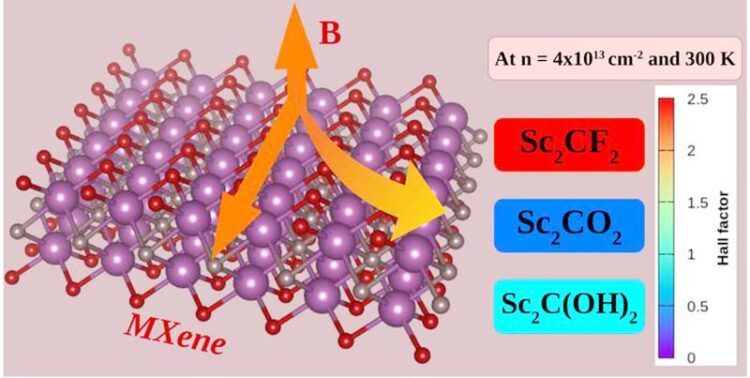MXene, a dream new material, paves the way for mass production

Predicted Hall Scattering Factor for Maxin
Credit: Korea Institute of Science and Technology
IKST researchers develop analysis model using magnetic transport characteristics of molecules attached to the surface of MXene. Establishment of property prediction and classification system is expected to be utilized to produce uniform quality MXene.
Developed in 2011, MXene is a two-dimensional nanomaterial with alternating metal and carbon layers, which has high electrical conductivity and can be combined with various metal compounds, making it a material that can be utilized in various industries such as semiconductors, electronic devices, and sensors. To properly utilize MXene, it is important to know the type and amount of molecules covered on the surface, and if the molecules covered on the surface are fluorine, the electrical conductivity of decreases and the efficiency of electromagnetic wave shielding decreases. However, since it is only 1 nm (nanometer – billionth of a meter) thick, it takes several days to analyze the molecules on the surface even with a high-performance electron microscope, so mass production has been impossible until now.
The research team led by Seung-Cheol Lee, director of the Indo-Korea Science and Technology Center(IKST) at the Korea Institute of Science and Technology(KIST), has developed a method to predict the distribution of molecules on the surface using the magnetoresistance property of MXene. By utilizing this method, it is possible to measure the molecular distribution of MXene with a simple measurement, enabling quality control in the production process, which is expected to open the way to mass production that was not possible until now.
The research team developed a two-dimensional material property prediction program based on the idea that electrical conductivity or magnetic properties change depending on the molecules attached to the surface. As a result, they calculated the magnetic transport properties of MXene and succeeded in analyzing the type and amount of molecules adsorbed on the surface of MXene at atmospheric pressure and room temperature without any additional devices.
By analyzing the surface of the MXene with the developed property prediction program, it was predicted that the Hall scattering factor, which affects magnetic transport, changes dramatically depending on the type of surface molecules. The Hall Scattering Factor is a physical constant that describes the charge-carrying properties of semiconductor materials, and the team found that even when the same MXene was prepared, the Hall Scattering Factor had a value of 2.49, the highest for fluorine, 0.5 for oxygen, and 1 for hydroxide, allowing them to analyze the distribution of the molecules.
The Hall scattering coefficient has different applications based on the value of 1. If the value is lower than 1, it can be applied to high-performance transistors, high-frequency generators, high-efficiency sensors, and photodetectors, and if the value is higher than 1, it can be applied to thermoelectric materials and magnetic sensors. Considering that the size of the maxin is a few nanometers or less, the size of the applicable device and the amount of power required can be dramatically reduced.
“Unlike previous studies that focused on the production and properties of pure MXene, this study is significant in that it provides a new method for surface molecular analysis to easily classify manufactured MXene,” said Seung-Cheol Lee, director of IKIST. “By combining this result with experimental studies, we expect to be able to control the production process of MXene, which will be used to mass produce MXene with uniform quality.”
IKST was established in 2010 and conducts research in the areas of theory, source code, and software for computational science. In particular, source code is a programming language that implements algorithms that can be modeled and simulated, and is considered an original research in the field of computational science, and the center conducts collaborative research with Indian universities and research institutes such as IIT Bombay to develop source code.
KIST was established in 1966 as the first government-funded research institute in Korea. KIST now strives to solve national and social challenges and secure growth engines through leading and innovative research. For more information, please visit KIST’s website at https://eng.kist.re.kr/
This research, which was conducted as a KIST Major Project (2Z06950) funded by the Ministry of Science and ICT (Minister Lee Jong-ho), was selected as a Notable Article of the Year (2023 Hot Article Collection) of Nanoscale, an international journal in the field of nanoscience (IF:6.7, JCR top 16.7%) for its originality and scalability, and was published on June 28.
Journal: Nanoscale
DOI: 10.1039/d2nr06409j
Article Title: Can magneto-transport properties provide insight into the functional groups in semiconducting MXenes?
Article Publication Date: 28-Jun-2023
All latest news from the category: Materials Sciences
Materials management deals with the research, development, manufacturing and processing of raw and industrial materials. Key aspects here are biological and medical issues, which play an increasingly important role in this field.
innovations-report offers in-depth articles related to the development and application of materials and the structure and properties of new materials.
Newest articles

Silicon Carbide Innovation Alliance to drive industrial-scale semiconductor work
Known for its ability to withstand extreme environments and high voltages, silicon carbide (SiC) is a semiconducting material made up of silicon and carbon atoms arranged into crystals that is…

New SPECT/CT technique shows impressive biomarker identification
…offers increased access for prostate cancer patients. A novel SPECT/CT acquisition method can accurately detect radiopharmaceutical biodistribution in a convenient manner for prostate cancer patients, opening the door for more…

How 3D printers can give robots a soft touch
Soft skin coverings and touch sensors have emerged as a promising feature for robots that are both safer and more intuitive for human interaction, but they are expensive and difficult…





















